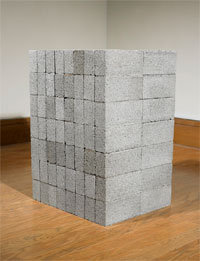WallCeilingFloor
dal 27/1/2007 al 3/3/2007
Segnalato da
27/1/2007
WallCeilingFloor
Birmingham Museum of Art, Birmingham
William Anastasi, Donald Judd and Fred Sandback. The exhibition presents selected works of three seminal artists who, beginning in the 1960’s, explored not only the forms and uses of the materials they used to create their objects, but also the relationships between these objects and the physical limits of the spaces in which they were to be placed. The key element is less the form than the open space defined by the gallery’s physical constraints, then transformed by the intrusions of the works into that space.

Works by William Anastasi, Donald Judd, and Fred Sandback
Curator: Gail Andrews
The exhibition presents selected works of three seminal artists who, beginning in the 1960’s,
explored not only the forms and uses of the materials they used to create
their objects, but also the relationships between these objects and the
physical limits of the spaces in which they were to be placed.
Before such explorations, art had traditionally been thought to be some
form of an object itself, whether hung on a wall or placed on a pedestal.
That assumption—the independence of the object from its framework—was and
is challenged by the works of Fred Sandback (1943-2003), Donald Judd
(1928-1994) and William Anastasi (b. 1932). Each of the works in this
exhibition should be seen not only as independent objects but also in
relationship to the walls, ceilings or floors. In fact, in certain of the
works, a key element is less the form of the chosen material than the open
space of the so-called “white box" defined by the gallery’s physical
constraints, then transformed by the intrusions of the works into that
space.
Fred Sandback used for his sculptures ordinary acrylic yarn. With
variously colored yarn, Sandback drew lines in space that generated
spatial tensions above, below and laterally within the space in which they
were installed. The dimensions of the principal sculptures in this
exhibition, The First of Sixteen Two-Part Variations of Two Diagonal
Lines, were conceived by Sandback to be variable in dimension depending
upon the three dimensions of a given space. They consist of two diagonal
stretches of cardinal red yarn, one ascending from a lower corner of the
room to the ceiling, the other descending from an upper corner of the room
to the floor. The sculptures produce a dynamic of competing spatial forces
that change as the viewer moves through the space. The viewer’s
interaction with the Diagonal Lines is itself a “variation" on them, such
that the individual perceptions of the viewer become indispensable
elements of the artwork.
Donald Judd mastered the art of precisely cut and mathematically ordered
structures, often fabricated in a series of rectangular prisms. Judd
typically used common industrial materials such as plywood, stainless
steel or Plexiglas in his work. His sculptures frequently take on the form
of stacks of “boxes" hung on a wall or placed directly on the floor; and
often incorporate elements of color, whether by means of Plexiglas
elements bonded to metal, or enameled or anodized paint applied directly
to the metal surfaces.
In all of his works, Judd used simplified forms to delineate and deform
the space surrounding each of them. The works themselves seem to bond with
the wall or floor. For example, his Wall Project (No. 32)—shown in this
exhibition for the first time in a museum setting—consists of two
galvanized iron plates inset into the wall in intervals spaced to divide
the wall into thirds. Judd’s instructions for fabricating the work require
that the dimensional ratio of the wall recesses to the height and length
of the plates equals 1:2:3. As set into the wall, the viewer is free to
question whether each iron plate is a separate “art object," whether the
two together are a work of art, whether the cut-out wall as a whole is the
work, whether the shadows within the recesses are elements of the work.
William Anastasi’s work is frequently not limited to a characteristic set
of materials or formal concerns. His works at times are defined by
mathematically determined limits, as with What Was Real in the World, a
stack of 112 concrete bricks laid in 7 tiers of 16 bricks each, a grouping
one might see on a construction site. Other works depend in large part on
chance determinants, as with Beethoven’s Fifth Symphony, a work created by
draping a videotaped performance of that symphony over two nails spaced at
the width of the artist’s arms stretched upward and outward diagonally.
Anastasi’s works in this exhibition reflect his intention to de-construct
the gallery site, whether by removing part of the wall’s own structure,
“drawing" lines on the wall by means of the shadows cast by a series of
embedded nails, or creating a plane of light in the space between the wall
and the ceiling by angling two sets of track lighting fixtures at each
other. The result is that the viewer has to rethink his perceptions of the
walls, ceiling and floor of the gallery, and what in fact is the art they
contain.
Image: William Anastasi - What Was Real in the World (1964)
The Birmingham Museum of Art
2000 Eighth Avenue North - Birmingham
Museum Hours: Tuesday - Saturday 10am - 5pm; Sunday 12 - 5pm



